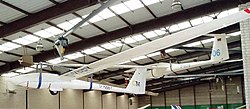Schleicher ASW 22
| ASW 22 | |
|---|---|

|
|
| Type: | Glider |
| Design country: | |
| Manufacturer: | |
| First flight: |
July 8, 1981 |
| Production time: |
1981-2008 |
| Number of pieces: |
87 |

The Schleicher ASW 22 is a single-seat high performance glider the open class of carbon fiber reinforced plastic . The designer is Gerhard Waibel , the manufacturer Alexander Schleicher . It was first built in 1981; the first flight took place on July 4, 1981.
Production was stopped in September 2008 in favor of the ASH 30 Mi.
The ASW 22 has a four-part wing with blow turbulators on the underside, double-deck airbrakes, a twin landing gear and a T-tail unit with a large rudder.
Versions
ASW 22
The first ASW 22 had a span of either 22 meters or 24 meters. With these spans, thin profiles could only be built from the then new carbon fiber composite materials. After approval in 1983, Schleicher wanted to compete against the Nimbus-3 , which was also enlarged in its wingspan . However, no world championship could be won with this version. The gliding index is 119 for the 22 m and 121 for the 24 m version.
ASW 22M
In 1983 three ASW 22 were equipped with engines by the company Binder Flugzeugbau, so that they could take off on their own. Two ASW 22M had the option of increasing their spans from 22 meters to 24 meters (one also has the option of flying the 22 m version with winglets), while the wing of one was built permanently to 24 meters. For many years these sailors flew with a so-called VVZ (preliminary traffic approval), before all of them in the factory were converted to the status of the BE at the time with the Rotax 505 and then fully approved.
AS 22-2
For this unique piece, the wing and tail unit of the ASW 22 were combined with a two-seat fuselage. The first flight took place on September 20, 1984 on the Wasserkuppe. The two-seater ASH 25 emerged from the design , for which Martin Heide enlarged the outer wing and also extended the span to 25 meters.
ASW 22B
The enlarged wing of the ASH 25 benefited the ASW 22B in 1985, which flew for the first time in April 1986. The flight characteristics turned out to be very good and in 1987 Ingo Renner was able to win the world championship on an ASW 22B, as did other ASW 22B pilots in the following years. A motor was built into the ASW 22BE version. The ASW 22BL came in 1992 with a further extended span of 26.4 meters. Her soaring index is 123.
Technical specifications
| ASW 22 (24 m) | ASW 22B | ASW 22BL | |
|---|---|---|---|
| span | 22 m (24 m) | 25 m | 26.4 m |
| Hull length | 8.1 m | ||
| Wing area | 14.9 m² (15.49 m²) | 16.3 m² | 16.67 m² |
| Wing extension | 32.47 (37.19) | 38.32 | 41.81 |
| Slightest sinking | 0.44 m / s (0.41 m / s) | 0.41 m / s | 0.41 m / s |
| Glide ratio | 54 (57) | 60 | 62 |
| Empty weight with minimum equipment | 400 kg (410 kg) | 455 kg | 465 kg |
| Water ballast | 240 kg (185 kg) | ||
| Max. Takeoff mass | 750 kg (650 kg) | ||
| Wing loading | Max. 50.3 kg / m² (41.9 kg / m²) | Max. 46.0 kg / m² | Max. 45.0 kg / m² |
| Top speed | 280 km / h | ||
| Minimum speed | 66 km / h | 69 km / h | 68 km / h |
See also
Web links
Individual evidence
- ↑ Production list ASW 22 . Retrieved May 3, 2020.
- ↑ Alexander Schleicher: All types of aircraft since 1951 , accessed on December 18, 2018.
- ↑ Record hunter from Poppenhausen . In: FlugRevue November 1984, p. 6